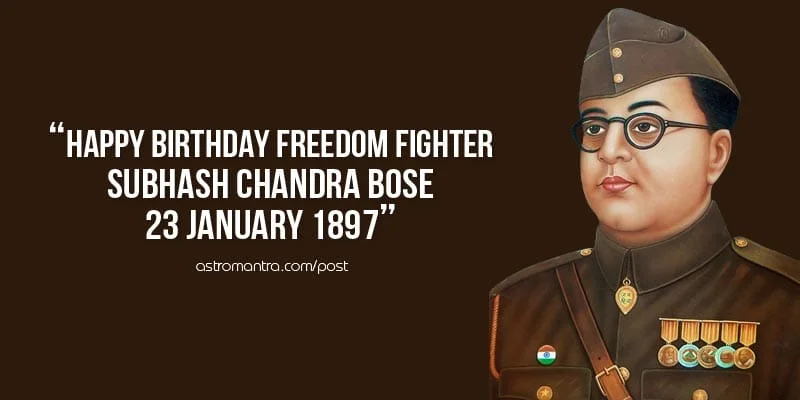Subhash Chandra Bose Biography

Subhash Chandra Bose Biography(नेताजी सुभाष चंद्र बोस): Subhash Chandra Bose was born on 23 January 1897 (at 12.10 pm) in Cuttack, Orissa Division, Bengal Province, to Prabhavati Devi and Janakinath Bose, an advocate belonging to a Kayastha family. He was the ninth in a family of 14 children. Subhash Chandra Bose (Subhash Chandra Bose Biography) was one of the most celebrated freedom fighters of India. He was a charismatic influencer of the youth and earned the epithet ‘Netaji’ by establishing and leading the Indian National Army (INA) during India’s struggle for independence. Although initially aligned with the Indian National Congress, he was ousted from the party due to his difference in ideology.
He sought assistance from Nazi leadership in Germany and Imperial forces in Japan during the World War II, to overthrow the British from India. His sudden disappearance post 1945, led to surfacing of various theories, concerning the possibilities of his survival. Netaji Subhash Chandra (Subhash Chandra Bose Biography) Bose was born on 23 January, 1897 in Cuttack (Orissa) to Janakinath Bose and Prabhavati Devi. Subhash(Subhas Chandra Bose Biography) was the ninth child among eight brothers and six sisters. His father, Janakinath Bose, was an affluent and successful lawyer in Cuttack and received the title of “Rai Bahadur”.
He later became a member of the Bengal Legislative Council. Subhash Chandra Bose(Subhash Chandra Bose Biography) was a brilliant student. He passed his B.A. in Philosophy from the Presidency College in Calcutta. He was deeply influenced by Swami Vivekananda’s teachings and was known for his patriotic zeal as a student. In an incident where Bose beat up his professor for his racist remarks, brought him notoriety as a rebel-Indian in eyes of the government. His father wanted Netaji(Subhash Chandra Bose Biography) to become a civil servant and therefore, sent him to England to appear for the Indian Civil Service Examination.
Bose was placed fourth with highest marks in English. But his urge for participating in the freedom movement was intense and in April 1921, he resigned from the coveted Indian Civil Service and came back to India. In December 1921, Bose was arrested and imprisoned for organizing a boycott of the celebrations to mark the Prince of Wales’ visit to India. During his stay in Berlin, he met and fell in love with Emily Schenkl, who was of Austrian origin. Bose and Emily were married in 1937 in a secret Hindu ceremony and Emily gave birth to a daughter Anita in 1942. Shortly after the birth of their daughter, Bose left Germany in 1943 to come back to India.
Initially, Subhash Chandra Bose(Subhash Chandra Bose Biography) worked under the leadership of Chittaranjan Das, an active member of the Congress in Calcutta. It was Chittaranjan Das, who along with Motilal Nehru, left Congress and founded the Swaraj Party in 1922. Bose regarded Chittaranjan Das as his political guru. He himself started the newspaper ‘Swaraj’, edited Das’ newspaper ‘Forward’ and worked as the CEO of Calcutta Municipal Corporation under Das’ stint as Mayor. Subhash Chandra Bose played an important role in enlightening the students, youths and laborers of Calcutta.
In his fervent wait to see India as an independent, federal and republic nation, he emerged as a charismatic and firebrand youth icon. He was admired within the congress for his great ability in organization development. He served several stints in prison for his nationalist activities during this time. To counter the British army, he formed the Indian National Army, famously known as ‘Azad Hind Fauz’. It was done with the help and active co-operation of the great revolutionary Rashbehari Bose and other patriots. INA was a very powerful and large unit of army. It was Subhas Chandra(Subhash Chandra Bose Biography) who became the commander-in-chief of this army.
The army was composed of both men and women soldiers of all other races. This national army declared war against the British on February, 1944. He called and addressed to the people of the country from Rangoon. ‘Give me blood. I will give you freedom’. For his extraordinary bravery, mental and moral strength to venture he became famous as ‘Netaji’. The details about his last days could not be traced with accuracy. No authentic information regarding the mystery of his disappearance has yet been known, but it is said that he died on an airplane accident on 18th August, 1945.
नेताजी सुभाष चंद्र बोस जीवन परिचय | Subhash Chandra Bose Biography
नेताजी सुभाष चंद्र बोस का जन्म 23 जनवरी 1897 को उड़ीसा में कटक के एक संपन्न बंगाली परिवार में हुआ था। बोस के पिता का नाम ‘जानकीनाथ बोस’ और माँ का नाम ‘प्रभावती’ था। जानकीनाथ बोस कटक शहर के मशहूर वक़ील थे। प्रभावती और जानकीनाथ बोस की कुल मिलाकर 14 संतानें थी, जिसमें 6 बेटियाँ और 8 बेटे थे। सुभाष चंद्र उनकी नौवीं संतान और पाँचवें बेटे थे। अपने सभी भाइयों में से सुभाष को सबसे अधिक लगाव शरदचंद्र से था। नेताजी(Subhas Chandra Bose Biography) ने अपनी प्रारंभिक पढ़ाई कटक के रेवेंशॉव कॉलेजिएट स्कूल में हुई। तत्पश्चात् उनकी शिक्षा कलकत्ता के प्रेज़िडेंसी कॉलेज और स्कॉटिश चर्च कॉलेज से हुई, और बाद में भारतीय प्रशासनिक सेवा (इण्डियन सिविल सर्विस) की तैयारी के लिए उनके माता-पिता ने बोस को इंग्लैंड के केंब्रिज विश्वविद्यालय भेज दिया।
अँग्रेज़ी शासन काल में भारतीयों के लिए सिविल सर्विस में जाना बहुत कठिन था किंतु उन्होंने सिविल सर्विस की परीक्षा में चौथा स्थान प्राप्त किया। 1921 में भारत में बढ़ती राजनीतिक गतिविधियों का समाचार पाकर बोस ने अपनी उम्मीदवारी वापस ले ली और शीघ्र भारत लौट आए। सिविल सर्विस छोड़ने के बाद वे भारतीय राष्ट्रीय कांग्रेस के साथ जुड़ गए। सुभाष चंद्र बोस महात्मा गांधी के अहिंसा के विचारों से सहमत नहीं थे। वास्तव में महात्मा गांधी उदार दल का नेतृत्व करते थे, वहीं सुभाष चंद्र बोस जोशीले क्रांतिकारी दल के प्रिय थे। महात्मा गाँधी और सुभाष चंद्र बोस के विचार भिन्न-भिन्न थे लेकिन वे यह अच्छी तरह जानते थे कि महात्मा गाँधी और उनका मक़सद एक है, यानी देश की आज़ादी। सबसे पहले गाँधीजी को राष्ट्रपिता कह कर नेताजी ने ही संबोधित किया था।
1938 में भारतीय राष्ट्रीय कांग्रेस का अध्यक्ष निर्वाचित होने के बाद उन्होंने राष्ट्रीय योजना आयोग का गठन किया। यह नीति गाँधीवादी आर्थिक विचारों के अनुकूल नहीं थी। 1939 में बोस पुन एक गाँधीवादी प्रतिद्वंदी को हराकर विजयी हुए। गांधी ने इसे अपनी हार के रुप में लिया। उनके अध्यक्ष चुने जाने पर गांधी जी ने कहा कि बोस की जीत मेरी हार है और ऐसा लगने लगा कि वह कांग्रेस वर्किंग कमिटी से त्यागपत्र दे देंगे। गाँधी जी के विरोध के चलते इस ‘विद्रोही अध्यक्ष’ ने त्यागपत्र देने की आवश्यकता महसूस की। गांधी के लगातार विरोध को देखते हुए उन्होंने स्वयं कांग्रेस छोड़ दी। इस बीच दूसरा विश्व युद्ध छिड़ गया। बोस का मानना था कि अंग्रेजों के दुश्मनों से मिलकर आज़ादी हासिल की जा सकती है।
उनके विचारों के देखते हुए उन्हें ब्रिटिश सरकार ने कोलकाता में नज़रबंद कर लिया लेकिन वह अपने भतीजे शिशिर कुमार बोस की सहायता से वहां से भाग निकले। वह अफगानिस्तान और सोवियत संघ होते हुए जर्मनी जा पहुंचे। सक्रिय राजनीति में आने से पहले नेताजी ने पूरी दुनिया का भ्रमण किया। वह 1933 से 36 तक यूरोप में रहे। यूरोप में यह दौर था हिटलर के नाजीवाद और मुसोलिनी के फासीवाद का। नाजीवाद और फासीवाद का निशाना इंग्लैंड था, जिसने पहले विश्वयुद्ध के बाद जर्मनी पर एकतरफा समझौते थोपे थे। वे उसका बदला इंग्लैंड से लेना चाहते थे। भारत पर भी अँग्रेज़ों का कब्जा था और इंग्लैंड के खिलाफ लड़ाई में नेताजी को हिटलर और मुसोलिनी में भविष्य का मित्र दिखाई पड़ रहा था। दुश्मन का दुश्मन दोस्त होता है।
उनका मानना था कि स्वतंत्रता हासिल करने के लिए राजनीतिक गतिविधियों के साथ-साथ कूटनीतिक और सैन्य सहयोग की भी जरूरत पड़ती है। सुभाष चंद्र बोस ने 1937 में अपनी सेक्रेटरी और ऑस्ट्रियन युवती एमिली से शादी की। उन दोनों की एक अनीता नाम की एक बेटी भी हुई जो वर्तमान में जर्मनी में सपरिवार रहती हैं। नेताजी हिटलर से मिले। उन्होंने ब्रिटिश हुकूमत और देश की आजादी के लिए कई काम किए। उन्होंने 1943 में जर्मनी छोड़ दिया। वहां से वह जापान पहुंचे। जापान से वह सिंगापुर पहुंचे। जहां उन्होंने कैप्टन मोहन सिंह द्वारा स्थापित आज़ाद हिंद फ़ौज की कमान अपने हाथों में ले ली। उस वक्त रास बिहारी बोस आज़ाद हिंद फ़ौज के नेता थे। उन्होंने आज़ाद हिंद फ़ौज का पुनर्गठन किया। महिलाओं के लिए रानी झांसी रेजिमेंट का भी गठन किया जिसकी लक्ष्मी सहगल कैप्टन बनी।
‘नेताजी’ के नाम से प्रसिद्ध सुभाष चन्द्र ने सशक्त क्रान्ति द्वारा भारत को स्वतंत्र कराने के उद्देश्य से 21 अक्टूबर, 1943 को ‘आज़ाद हिन्द सरकार’ की स्थापना की तथा ‘आज़ाद हिन्द फ़ौज’ का गठन किया इस संगठन के प्रतीक चिह्न पर एक झंडे पर दहाड़ते हुए बाघ का चित्र बना होता था। नेताजी अपनी आजाद हिंद फौज के साथ 4 जुलाई 1944 को बर्मा पहुँचे। यहीं पर उन्होंने अपना प्रसिद्ध नारा, “तुम मुझे खून दो, मैं तुम्हें आजादी दूंगा” दिया। 18 अगस्त 1945 को टोक्यो (जापान) जाते समय ताइवान के पास नेताजी का एक हवाई दुर्घटना में निधन हुआ बताया जाता है, लेकिन उनका शव नहीं मिल पाया। नेताजी की मौत के कारणों पर आज भी विवाद बना हुआ है।


